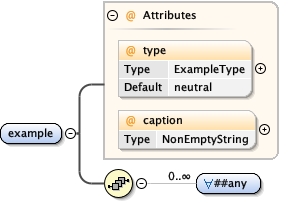| Namespace | No namespace | ||||||||||||||||||
|
Diagram
|
 |
||||||||||||||||||
|
Properties
|
|
||||||||||||||||||
|
Used by
|
|
||||||||||||||||||
| Model |
ANY element from ANY namespace
|
||||||||||||||||||
|
Attributes
|
|
||||||||||||||||||
|
Source
|
|